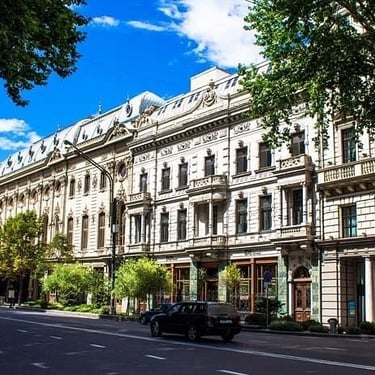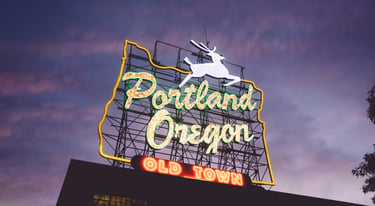Exploring Tbilisi: The Vibrant Capital of Georgia
Step into Tbilisi, Georgia’s captivating capital, where centuries of history meet vibrant modern life. Explore the city's rich heritage from ancient Silk Road connections to a unique blend of Persian, Ottoman, and Georgian influences. Wander through charming streets, admire the stunning architecture from the historic Narikala Fortress to the modern Peace Bridge and unwind in the iconic sulfur baths of Abanotubani. Savor traditional Georgian dishes like khachapuri and khinkali, and dive into Tbilisi's thriving arts scene with galleries, music festivals, and more. Join us on ExplorifyNow to uncover the heart of Tbilisi and start planning your unforgettable adventure.
Peter Komfolio
10/28/202410 min read








Narikala Fortress, Tbilisi, Georgia
The Bridge of Peace, Tbilisi, Georgia
Tbilisi Old Town, Tbilisi, Georgia
Sulfur Baths in Abanotubani, Tbilisi, Georgia
Rustaveli Avenue, Tbilisi, Georgia
Mtatsminda Park, Tbilisi, Georgia
Chronicle of Georgia Monument, Tbilisi, Georgia
Holy Trinity, Tbilisi, Georgia
Discover More About Tbilisi!
Click below to explore everything this stunning destination has to offer


A Glimpse into Tbilisi's History
Tbilisi, the capital of Georgia, boasts a history that dates back to the 5th century. Its origins can be traced to King Vakhtang I Gorgasali, who established the city as a strategic settlement due to its location along the Silk Road. This pivotal position not only facilitated trade but also encouraged cultural exchange, laying the groundwork for Tbilisi’s reputation as a cultural melting pot.
Throughout its history, Tbilisi has been influenced by various conquerors, each leaving an indelible mark on its architecture, language, and traditions. In the 7th century, the city came under the rule of the Arab Caliphate, which introduced Islamic culture and architecture, further diversifying Tbilisi’s cultural landscape. Following this period, the city was absorbed into the Kingdom of Georgia, becoming a significant center for the arts and education during the 12th century Golden Age.
The strategic importance of Tbilisi continued as it became a target for invasion by the Persians and Ottomans in the subsequent centuries. Each ruling power conferred their customs and beliefs upon the city, enriching its tapestry of cultures. Particularly during the Ottoman rule, Tbilisi flourished as a cultural and commercial hub, as artisans and traders flocked to its streets.
The 20th century was marked by Soviet rule, which brought about significant changes in Tbilisi’s infrastructure and industry. Though the city underwent a period of industrialization, this era also suppressed many of its cultural expressions. However, with the collapse of the Soviet Union in the early 1990s, Tbilisi emerged once again as a beacon of culture and history, preserving its unique heritage while embracing modernity. Today, Tbilisi stands as a vibrant testament to the myriad influences that have shaped it over the centuries.
Eclectic Architecture: A Blend of Old and New
Tbilisi, the capital of Georgia, is renowned for its eclectic architecture that vividly narrates the city’s historical evolution. The city's skyline is an intriguing amalgamation of medieval structures, neoclassical buildings, and modern designs, creating a distinctive character that reflects the rich cultural tapestry of the region. One cannot overlook the prominent Narikala Fortress, perched majestically on a hill overlooking Tbilisi. Originally constructed in the 4th century, this ancient fortress offers a glimpse into Georgia's storied past, while also serving as a symbol of resilience and strength. The site not only draws history enthusiasts but also stands as a testament to the architectural prowess of its time, making it a significant landmark in the city.
In contrast to the fortifications of the past, Tbilisi also boasts contemporary marvels like the Peace Bridge. This modern pedestrian bridge, completed in 2010, embodies a stark yet harmonious juxtaposition to the town’s historic core. Its sleek design, featuring a steel and glass structure illuminated by LEDs at night, signifies a forward-looking vision that embraces the modern era while paying homage to the cultural roots beneath. The bridge serves as a vital connector across the Kura River, linking diverse neighborhoods and fostering a sense of unity in a city that balances tradition and progress.
Throughout Tbilisi, visitors can explore a harmonious blend of architectural styles, from the intricate facades of modernist buildings to the charming wooden balconies typical of the Old Town. This stylistic diversity showcases the city's dynamic nature and its evolution over centuries. The coexistence of ancient and contemporary architecture not only enriches the urban fabric but also emphasizes Tbilisi's role as a vibrant cultural hub, inviting exploration and appreciation from all who visit.
Charming Streets and Scenic Views
The city of Tbilisi, the capital of Georgia, is renowned for its enchanting streets that echo centuries of history and culture. Strolling through the narrow, winding paths of Old Tbilisi, visitors are greeted by a remarkable tapestry of architecture, with intricate wooden balconies and vibrant facades that reflect the city’s diverse past. This neighborhood is a crucial part of Tbilisi's identity, where each corner tells a story shaped by various influences, from Persian to Soviet. The cobblestone pathways add to the charm, inviting explorers to engage with the surroundings while experiencing the lively atmosphere created by shops, cafes, and artisans.
Further enhancing the city’s allure is Rustaveli Avenue, which serves as a central thoroughfare and a hub for cultural activities. This broad avenue features an array of theaters, galleries, and governmental buildings, allowing visitors to immerse themselves in Tbilisi’s artistic inclinations. As one ambles along this stretch, iconic landmarks such as the Georgian National Opera Theater and the Parliament of Georgia come into view, exemplifying the city’s blend of tradition and modernity. The vibrant energy of Rustaveli Avenue culminates in a variety of dining options, ensuring that there is something to capture the palate of every visitor.
The scenic views in Tbilisi are equally captivating. The city is nestled within a picturesque valley flanked by the mighty Caucasus Mountains. Visitors can find remarkable vantage points, such as the Narikala Fortress, which overlooks the Kura River, offering breathtaking panoramas of the urban landscape. The contrasting colors and unique architectural styles of Tbilisi are best appreciated from these heights, especially during sunset when the city bathes in hues of gold and purple. The confluence of charming streets and stunning vistas makes Tbilisi not just a destination but an experience that resonates long after one departs.
Cultural Heritage and Artistic Spirit
Tbilisi, the capital of Georgia, is a city where cultural heritage and artistic spirit intertwine seamlessly. Its rich history is reflected in the architecture, traditions, and artistic expressions that define the city. The diverse influences of Persian, Russian, and Ottoman cultures have played a significant role in shaping Tbilisi's identity, making it a unique cultural hub in the region.
The city's vibrant art scene is evident in its numerous galleries, exhibitions, and cultural events. Tbilisi boasts a plethora of art galleries, each showcasing the works of both established and emerging local artists. These spaces often serve as platforms for contemporary art, bridging the gap between traditional Georgian art forms and modern expressions. Prominent galleries such as the Art Palace and the Museum of Modern Art are essential stops for those looking to immerse themselves in the evolving artistic landscape.
Music is another vital aspect of Tbilisi's cultural fabric. The city is renowned for its diverse musical heritage, which includes traditional Georgian polyphonic singing, folk music, and contemporary styles. Numerous festivals celebrate this rich musical tradition, such as the Tbilisi Jazz Festival, which attracts international acts and showcases local talent, fostering a sense of community and cultural pride among residents and visitors alike.
Performing arts also hold a prominent place in Tbilisi's cultural scene. The city's theaters and performance spaces regularly host a variety of productions, from classical plays to innovative modern performances. This dedication to the arts is evidence of Tbilisi's commitment to preserving its cultural heritage while embracing contemporary creativity.
The interplay of local traditions, artistic expression, and the contemporary art scene contributes significantly to Tbilisi's cultural vibrancy. This dynamic environment not only enriches the lives of its residents but also captivates visitors, making it an essential destination for anyone interested in exploring the cultural heritage and artistic spirit of Georgia.
Culinary Delights: A Taste of Tbilisi
Tbilisi, the capital of Georgia, boasts a rich culinary tapestry that reflects the country's diverse history and cultural influences. Traditional Georgian cuisine is renowned for its bold flavors, hearty dishes, and emphasis on fresh, local ingredients. Among the most iconic offerings is khachapuri, a delicious cheese-filled bread that comes in various regional varieties, such as the Adjarian khachapuri, which is shaped like a boat and topped with a creamy egg and butter. This beloved dish has become a staple not only in Tbilisi but across the entire nation, symbolizing Georgian hospitality.
Another signature dish is khinkali, a type of dumpling filled with succulent meat or cheese and spiced with aromatic herbs. The art of eating khinkali lies in their preparation—one must hold the top knot, take a careful bite, and sip the savory broth before devouring the entire dumpling. This experience is quintessentially Georgian and is often enjoyed in local establishments where the atmosphere is as inviting as the food.
The local wine culture is equally impressive, with Georgia recognized as one of the world's oldest wine-producing regions. Tbilisi is home to numerous wine bars and restaurants that showcase a range of indigenous grape varieties, such as Saperavi and Rkatsiteli. Visitors can embark on a unique tasting journey, exploring traditional qvevri wines, which are fermented in clay vessels, embodying the rich heritage of Georgian viticulture.
For modern dining experiences, numerous restaurants in Tbilisi combine traditional cooking with contemporary flair. Establishments like "Funicular" offer stunning views paired with innovative interpretations of classic dishes, while "Shavi Lomi" is celebrated for its creative menu that highlights local ingredients. As one traverses the vibrant streets of Tbilisi, the culinary delights await, promising a gastronomic adventure that is sure to enchant all who visit.
Experiencing the Thermal Baths: A Relaxing Tradition
Tbilisi, the vibrant capital of Georgia, is renowned for its historic sulfur baths that play a crucial role in the city's social fabric and cultural heritage. Nestled in the old district of Abanotubani, these baths have been an integral part of Tbilisi's identity for centuries. The therapeutic properties of the naturally heated sulfuric water, which is rich in minerals, have been praised since the 5th century, believed to offer various health benefits including skin healing, detoxification, and relaxation. Many visitors are drawn to the baths not only for their reputed health benefits but also for their unique ambiance and social atmosphere.
Each bathhouse offers a different experience, but they typically feature spacious communal areas and private rooms, allowing guests to choose their preferred level of intimacy and comfort. Traditional bathhouses often showcase beautiful Georgian architecture, characterized by ornate brickwork and domed roofs that add to the overall aesthetic. Guests can indulge in various wellness treatments, including massages, scrubs, and even wine therapies, which further enhance the experience of relaxation and rejuvenation.
Among the most popular bathhouses in Tbilisi is the Orbeliani Bathhouse, known for its stunning mosaic-tiled interiors and excellent service. Another noteworthy establishment is the Sulphur Bathhouse, where many locals frequent, offering an authentic experience steeped in tradition. Visitors can expect to engage with both locals and travelers, as these baths serve as a social hub where people gather to unwind, share stories, and appreciate the communal spirit.
Overall, experiencing Tbilisi's sulfur baths is not merely about enjoying a therapeutic soak; it is a gateway into the city's rich history and enduring traditions, making it a quintessential aspect of a visit to Georgia's capital. The baths provide a unique blend of relaxation and cultural immersion, reinforcing Tbilisi's reputation as a welcoming and distinctive destination.
Planning Your Visit to Tbilisi
Planning a visit to Tbilisi, the vibrant capital of Georgia, can be an exhilarating experience thanks to the city's rich history, diverse culture, and stunning architecture. To make the most of your trip, it is essential to consider several key factors, including the best times to visit, transportation options, suitable accommodations, and notable attractions.
The ideal time to visit Tbilisi is during the spring (April to June) and autumn (September to November) months when the weather is pleasantly mild, making it perfect for exploring the city's various sites. Summers can be hot, reaching into the high 30s (Celsius), while winter brings temperatures that can drop below freezing, which may not be appealing for all travelers.
Getting around Tbilisi is relatively easy, with a range of transportation options available. The Tbilisi Metro is a convenient and affordable way to navigate the city, with several lines connecting key areas. Additionally, buses and marshrutkas (minibuses) offer efficient travel options. For a more intimate exploration of the city, consider walking or renting a bicycle, allowing you to fully appreciate Tbilisi’s unique charm.
Accommodation in Tbilisi varies from luxury hotels to budget-friendly hostels, catering to all types of travelers. Popular areas to stay include the Old Town, which provides easy access to historical landmarks, and the vibrant Rustaveli Avenue, known for its cultural attractions and shops. Online platforms can help find the best pricing and reviews that suit individual preferences.
During your visit, don't miss must-see attractions such as the historic Narikala Fortress, the beautiful sulphur baths of Abanotubani, and the architectural marvel of the Tbilisi Bridge of Peace. These highlights, coupled with the city’s vibrant atmosphere, will undoubtedly make your trip to Tbilisi unforgettable.
What is the Alaska Airlines Mileage Plan?
If you love to travel, you’ll want to know all about the Alaska Airlines Mileage Plan. This frequent flyer program is designed for those who frequently fly with Alaska Airlines or its partner airlines. But what makes it special? Unlike most programs, the Mileage Plan rewards members based on the distance flown, rather than the amount of money spent on tickets. This unique approach benefits long-haul travelers, allowing them to rack up miles faster and experience more rewards.
How Do You Earn Miles?
Earning miles with the Alaska Airlines Mileage Plan is all about the journey. For every mile you fly, you can earn miles in your account. This means that if you’re jet-setting across the globe, you’re not just earning a seat on your flight; you’re also collecting valuable miles that can lead to free flights or upgrades. Whether you’re flying with Alaska or a partner airline, each flight can build up your mileage balance significantly. Also, consider that some partners might offer bonus miles, so always check before booking your tickets.
Redeeming Your Miles: More Than Just Flights
One of the greatest advantages of the Alaska Airlines Mileage Plan is its flexibility when it comes to redeeming miles. While most people think of using miles for flights, this program allows for much more. You can redeem your hard-earned miles for seat upgrades that can make your flying experience much more comfortable. Beyond the skies, these miles can also be exchanged for hotel stays, car rentals, and even exclusive experiences, making your travels much more enjoyable.
If you’re considering enrolling in the Alaska Airlines Mileage Plan, it’s definitely a good move if you fly often. With its member-friendly features, this mileage plan offers a unique structure that not only rewards you for the number of miles flown but also allows for diversified redemption options, making it a versatile program for any traveler. So, pack your bags, and get ready to start earning miles with Alaska Airlines.








